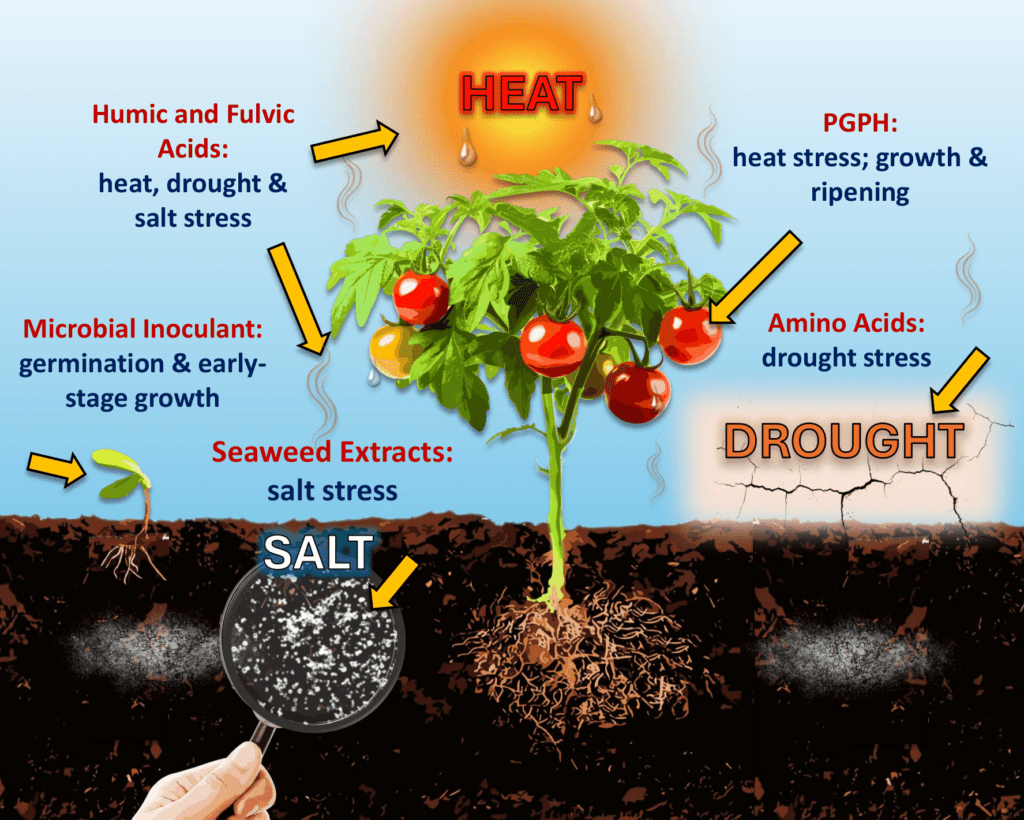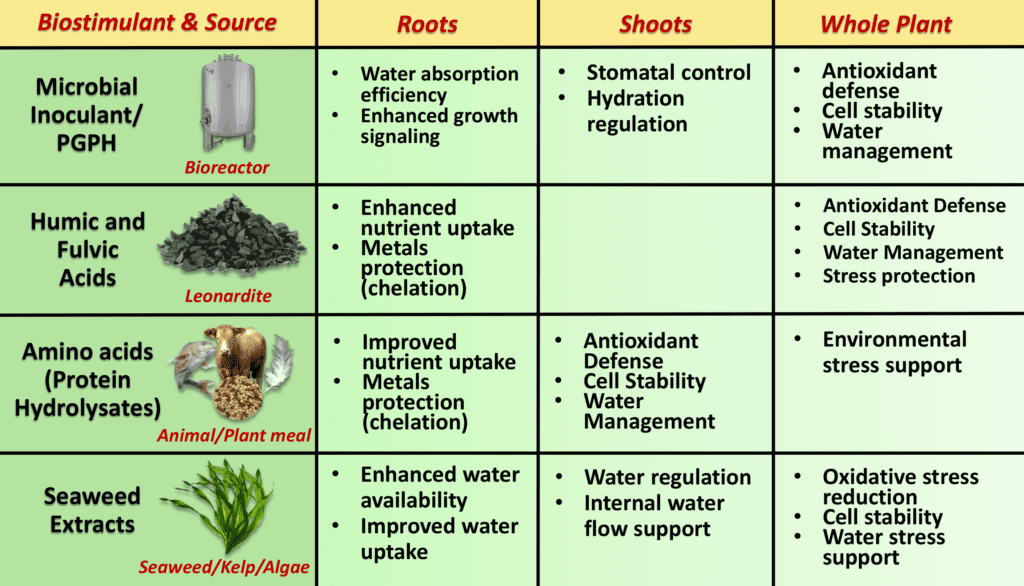Enhancing crop productivity and environmental health with biostimulants
The agricultural sector is under increasing pressure to escalate food production while simultaneously limiting any impact on the environment. Conventional farming methods, heavily reliant on synthetic fertilizers, pesticides and tillage, have raised such concerns due to their well-documented effects on soil and water resources, not to mention cost.
Thanks to advances in applied research and large-scale production, though, agricultural biostimulants have garnered quite a bit of attention as a potentially sustainable and innovative agronomic solution. Biostimulants are generally defined as naturally sourced biological substances or microorganisms that are applied to plants and soils, with the aim of enhancing nutrient uptake efficiency, building tolerance to abiotic stress, and boosting crop quality and yield.
Types of Biostimulants
The advent of biostimulants marks a significant pivot toward ecological farming practices. Far from being mere substitutes for chemical inputs, these biologically complex substances enhance plant growth and soil health through a multitude of mechanisms. They are gaining recognition due to their potential to not only increase crop yields and improve plant resilience but also to lessen the dependency on conventional chemical inputs.
By augmenting natural soil processes and improving nutrient availability, biostimulants present a complementary approach to traditional soil management. However, the key to their success lies in the careful consideration of their interactions with existing soil ecosystems, ensuring they enhance rather than disturb the delicate balance of soil health.
The spectrum of biostimulants is broad and diverse, with each type offering distinct benefits; however, there is often overlap in function, underscoring their multifaceted roles in enhancing plant growth and soil health. Figure 1 provides a brief summary of the documented effects various biostimulants have in terms of alleviating specific environmental stressors: heat, salt or salinity, and drought.

Microbial Inoculants
These include beneficial bacteria and fungi like mycorrhizal fungi and plant-growth-promoting rhizobacteria (PGPR). They enhance soil microbial diversity, which is crucial for nutrient cycling and organic matter decomposition. These inoculants help plants in nutrient and water absorption and can play a significant role in sustainable agriculture by forming symbiotic relationships with plant roots.
Humic and Fulvic Acids
These are complex organic substances resulting from the microbial degradation of plant and animal residues. Humic substances consist of humins, humic acids and fulvic acids, differentiated by their solubility across different pH levels. Humic acids dissolve in alkaline solutions and precipitate in acidic conditions, while fulvic acids are soluble in both. They play a crucial role in improving soil fertility, enhancing root nutrition, increasing water retention, and boosting nutrient uptake — particularly phosphorus — through ion exchange and interaction with soil minerals.
Protein Hydrolysates and Amino Acids
Derived from plant and animal proteins, protein hydrolysates are a mix of amino acids, peptides and polypeptides. They enhance plant performance, improve iron and nitrogen metabolism, and increase nutrient and water uptake. The use of these hydrolysates in agriculture has been linked to increased soil microbial activity and improved plant resilience against environmental stresses.
Seaweed Extracts
Long used in agriculture, seaweed extracts are derived primarily from brown algae species like Ascophyllum nodosum and Sargassum. They act as biostimulants, improving nutrient uptake and utilization, as well as enhancing seed germination, plant growth and yield. These extracts contain plant growth hormones and other bioactive compounds that can contribute to stress resistance in plants.
From seaweed extracts to protein hydrolysates and microbial inoculants, the choice is diverse. Yet, the efficacy of these biostimulants hinges on selecting the right type for specific crops and environmental conditions. Figure 2 provides a summary of some of the main extracts and their reported affects on roots, shoots, and whole plants.

Soil Health Improvement with Biostimulants
Biostimulants, notably humic and fulvic acids, have been linked to enhancements in soil health, contributing to a favorable environment for plant growth. For instance, humic acids are known to improve soil structure, with some studies suggesting an increase in soil porosity by as much as 15 percent, which may lead to better root development and more efficient water and nutrient uptake.
The moisture retention of soil can be substantially improved by biostimulants such as seaweed extracts and humic substances, with a documented potential increase in water retention capacity of up to 30 percent compared to untreated soil. This property is especially beneficial in regions with organic-matter-poor soils, possibly reducing irrigation frequency and enhancing drought resistance.
These natural compounds also aim to increase nutrient accessibility, with some biostimulants enhancing the availability of phosphorus in the soil by up to 20 percent. Their contribution to nitrogen cycling and the buildup of organic matter can further enrich soil nutrition and structure.
However, the exact mechanisms of biostimulants in improving soil fertility are not fully understood. While the chelating effects of humic acids are recognized, they may not be as significant as the natural turnover of these substances within soil organic matter. Other aspects, such as the involvement of plant-growth-promoting hormones (PGPH), might be more influential, though products containing humic and fulvic acids are subject to less stringent regulations compared to hormone-based soil amendments.
Microbial Influence and Erosion Control
The application of microbial inoculants, such as PGPR and mycorrhizal fungi, are known to promote microbial diversity in the soil; this is essential for organic matter decomposition and nutrient cycling. These microbes can increase the effective root surface area, improving nutrient and water uptake. Additionally, biostimulants can enhance soil stability, potentially reducing erosion and maintaining soil ecosystem health.
Plant Growth Promotion and Enhanced Yield
Biostimulants are significant contributors to plant growth, containing hormones that can increase the rate of cell division by up to 25 percent, as observed with cytokinin-based biostimulants. They also enhance root development, with biostimulants like mycorrhizal fungi increasing root biomass by up to 20 percent in various crops. Trials have shown a 10-15 percent increase in photosynthetic rate in crops treated with amino-acid-based biostimulants. Moreover, these compounds can increase nutrient uptake efficiency by up to 25 percent and the concentration of essential micronutrients in plant tissues by up to 30 percent.
Biostimulants also bolster plant resilience, inducing systemic resistance to stressors and reducing oxidative stress by up to 40 percent. Their use has been associated with up to a 50 percent reduction in disease incidence in treated plants. Field trials report yield increases ranging from 10 to 30 percent across various crops, with biostimulants improving the nutritional quality of produce, such as a 20 percent increase in vitamin C content in vegetables.
Figure 3. Biostimulants and their expected benefits, including when and how to apply them.
| Type | Production Method | Target Benefits | When to Apply | Application Method |
| Inoculants | Fermentation or culturing of microorganisms | Germination, growth promotion, pathogen resistance, and low water availability | Apply when enhancing root colonization and nutrient uptake, especially in early growth stages | Seed treatment, soil application, foliar spray |
| Humic and Fulvic Acids | Chemical extraction from leonardite | Improved soil structure, nutrient availability, and stress resistance against salinity and drought | Use for improving soil quality and plant stress resistance, beneficial throughout the growing season | Soil application, foliar spray |
| Amino Acids | Chemical extraction from animal or plant sources or chemically synthesized | Growth, resilience, and recovery; particularly effective against heat and drought stress | Apply to enhance stress tolerance and recovery, particularly useful during periods of environmental stress | Foliar spray, fertigation |
| Plant Growth-Promoting Hormones (PGPH) | Fermentation or chemical synthesis | Plant growth regulation and development; effective in heat stress management | For specific growth regulation, like fruit enlargement or ripening, typically during specific growth phases | Foliar spray, soil application |
| Seaweed Extracts | Harvested seaweed processing | Minerals, growth hormones, and resilience against salinity, drought, and heat stress | Ideal for promoting overall plant health and stress tolerance, especially during vegetative growth | Foliar spray, soil drench |
Ongoing Research and Development
Recent research continues to affirm the benefits of biostimulants. PGPR rhizobacteria have enhanced maize growth and yield significantly under greenhouse conditions, and arbuscular mycorrhizal fungi have shown efficacy in chickpea yield improvement. Humic and fulvic acids have demonstrated potential in improving soil fertility and root growth in turfgrass, while biostimulants containing microbial strains have activated metabolic processes and reduced stress in strawberry plants.
As the agricultural sector progresses, the role of biostimulants in promoting sustainable practices is becoming increasingly evident, with research aiming to fully understand their mechanisms and maximize their benefits.
Figure 4. Crop-specific summary of documented response after application of specific biostimulants.
| Crop Type | Biostimulant Type | Source/Type | Documented Response |
| Citrus sinensis (Orange) | Mycorrhizal inoculant: Glomus mosseae | Symbiotic association with plant roots | Enhanced growth and yield under nutrient-limiting conditions |
| Cucumis melo (Melon) | Inoculant: Trichoderma spp. | Fermentation of microorganisms | Alleviated salt stress; antagonistic activity against Pythium spp. |
| Daucus carota (Carrot) | Humic acid | Humic acid extraction from organic matter | Enhanced root growth and yield, soil structure, and water retention |
| Fragaria × ananassa (Strawberry) | Seaweed extract: Ecklonia maxima | Marine seaweed processing | Enhanced fruit yield and quality under stress conditions |
| Glycine max (Soybean) | Inoculant: Bacillus and Trichoderma spp. | Fermentation of microorganisms | Increased biomass and stress resilience |
| Glycine max (Soybean) | Fulvic acid | Fulvic acid extraction from organic matter | Enhanced root growth and nutrient uptake |
| Malus domestica (Apple) | Humic acid | Humic acid extraction from organic matter | Enhanced root growth and yield, soil water retention |
| Oryza sativa (Rice) | Inoculant: Azospirillum and Burkholderia spp. | Fermentation of microorganisms | Increased grain yield and potassium uptake |
| Solanum lycopersicum (Tomato) | Seaweed extract | Marine seaweed processing | Enhanced growth and stress mitigation |
| Triticum aestivum (Wheat) | Amino acid | Chemical synthesis from natural sources | Enhanced growth and nutrient assimilation |
| Triticum aestivum (Wheat) | Inoculant: microbial consortium | Fermentation of microorganisms | Enhanced growth, yield, and resilience to environmental stresses |
| Zea mays (Corn) | Plant-growth-promoting rhizobacteria (PGPR) | Fermentation of microorganisms | Increased growth and yield under stress conditions |
Regulatory Landscape and Market Growth
The regulatory landscape for biostimulants is evolving to address the growing interest in sustainable farming practices and to ensure product safety and effectiveness. Under the Pesticide Registration Improvement Act 4, the Environmental Protection Agency has established a category for voluntary, registrant-initiated assessment of products to determine if they qualify as biostimulants exempt from the Federal Insecticide, Fungicide, and Rodenticide Act (FIFRA) regulations. The biostimulant industry is encouraged to engage with the EPA to develop an effective review process for product categorization assessments (Biological Products Industry Alliance).
As the market for biostimulants grows, with projections indicating a potential reach of $3.5 billion by 2025, it is essential for stakeholders, including manufacturers, distributors and users, to stay informed about these regulations and to participate in the ongoing development of standards and practices that support the safe and effective use of biostimulants in agriculture.
Conclusion
Biostimulants are revolutionizing agriculture, offering ecological and effective solutions for enhancing crop productivity, soil health and environmental sustainability. Their diverse applications, from traditional farming to urban agriculture and bioremediation, underscore their potential in sustainable agricultural practices and environmental management. As the agricultural sector evolves, biostimulants could play an increasingly vital role in shaping a more productive, environmentally responsible and sustainable agricultural landscape. However, given mixed results in certain cases, the need for continued applied research is needed to make better use of these naturally sourced materials.
Patrick Freeze is a soil health scientist, research and development manager, and technical specialist at Ward Labs. He earned his Ph.D. in soil chemistry from Washington State University where he studied soil health and heavy metal chemistry as a USDA NIFA Needs Fellow and in Thailand as a U.S. Fulbright Scholar.















